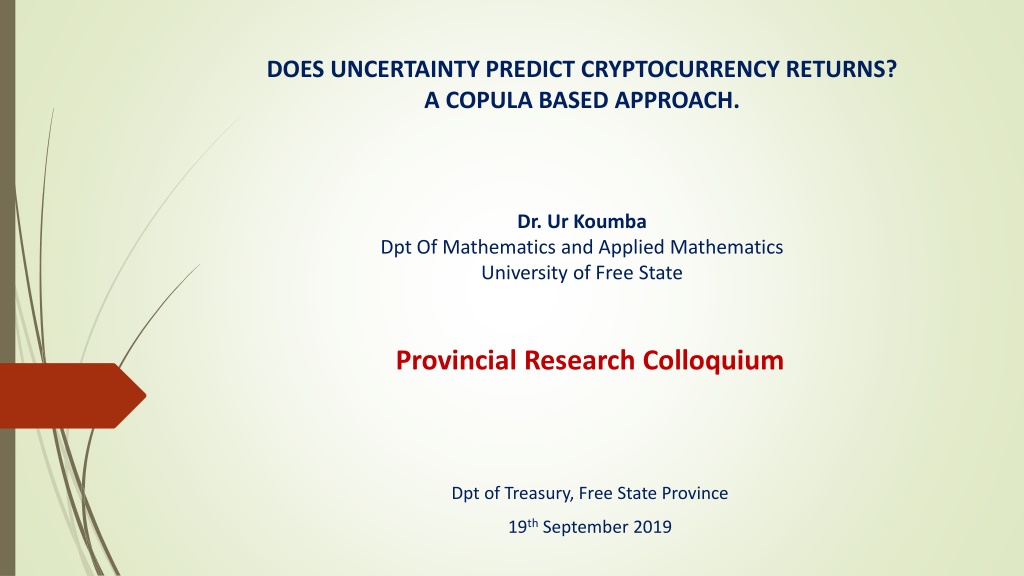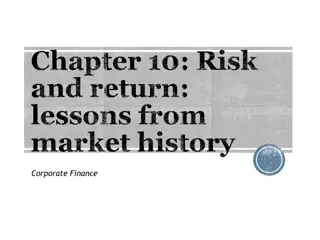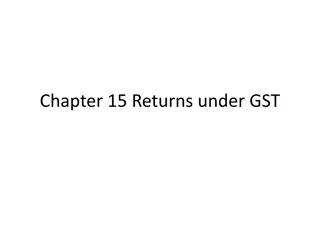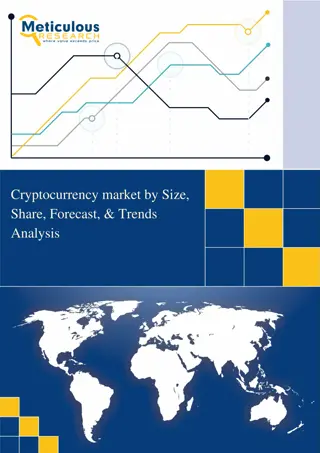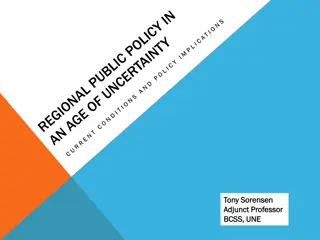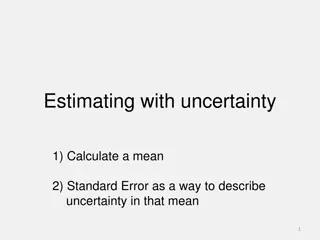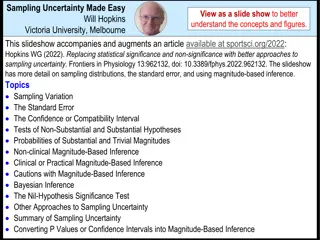Uncertainty in Cryptocurrency Returns: An Analysis Using Copula Approach
Amidst the rise of cryptocurrencies, particularly Bitcoin, this study by Dr. Ur Koumba explores the relationship between uncertainty and cryptocurrency returns using a Copula-based approach. The research delves into the impact of uncertainty on the volatile nature of cryptocurrencies, shedding light on potential determinants of Bitcoin's volatility and its implications in the global financial landscape.
Download Presentation

Please find below an Image/Link to download the presentation.
The content on the website is provided AS IS for your information and personal use only. It may not be sold, licensed, or shared on other websites without obtaining consent from the author. Download presentation by click this link. If you encounter any issues during the download, it is possible that the publisher has removed the file from their server.
E N D
Presentation Transcript
DOES UNCERTAINTY PREDICT CRYPTOCURRENCY RETURNS? A COPULA BASED APPROACH. Dr. Ur Koumba Dpt Of Mathematics and Applied Mathematics University of Free State Provincial Research Colloquium Dpt of Treasury, Free State Province 19thSeptember 2019
Contents Introduction Literature Review Objectives of the study Methodology Results Conclusion
Introduction In the midst of the financial crisis of 2008-2009, creation of the 1st ever virtual currency called Bitcoin (BTC) which is an advanced application of cryptography. BTC is a unique and newly secure digital currency completely different from the traditional fiat currency. All operational transactions done through Blockchain(public ledger ). This is a decentralized peer-to-peer electronic payment system that has no government control and free from any central financial bodies. BTC also offers an almost non- existent transaction subscription that defeats the purpose of traditional payment methods to buy or sell goods and online services. Although BTC was introduced in 2009, it only started to become popular from the exponential growth expressed in 2013. In a similar fashion, an emerging class of cryptocurrencies has shown an unprecedented expansion owing to cryptocurrency market. Quite a number of cryptocurrencies were produced to respond mainly to the insufficiencies of Bitcoin. extensive supply and demand from
Introduction Bitcoin, Ethereum, Ripple, Litecoin, Ethereum Classic, Monero, Dash, Augur, MaidSafeCoin and Waves are considered the top ten cryptocurrencies. Although Bitcoin remains in market capitalization leadership with more than 81% of the overall cryptocurrency market, an estimate rise of more than 720 other cryptocurrencies was already indicated in November 2016 with Ethereum (ETH) and Ripple (XRP) to respectively represent the second (7.6%) and third (2,4%) largest crypto currencies. Cryptocurrency academics, financial experts, and policy makers to provide more attractable financial constraints. ecosystem has significantly drawn enough attention to Academics cryptocurrencies and an ever more important aspect indicates the potential impacts on people who benefited from cryptocurrencies usage. However, one noteworthy observation that remains is the debate on potential determinants of Bitcoin s volatility. have currently produced more than 300 papers related to
Literature Review cryptocurrency has received a huge amount of criticism due mainly to the inability from governments or central financial institutions to control its fluctuations. Subsequently, cryptocurrency makes it difficult to access transaction fees and to reduce the risk of money laundry amongst other fraudulent activities. Store of value, unit of account and medium of exchange are the main characteristics of an ideal currency (Mankiw, 2007). The extremely volatile behavior of Bitcoin, in comparison to traditional currencies, may jeopardize its chance of becoming an ideal currency (Yermack, 2013; Lo and Wang, 2014; Kancs et al., 2015). This has triggered research interest in finding the determinants of such volatility. Academics have indicated factors such as the global macroeconomic, the market force of supply and demand and Bitcoin attractiveness to be the more significant drivers of Bitcoin excessive price formation (Buchholz et al., 2012; van Wijk, 2013; Kristoufek, 2015; Kancs et al., 2015).
Literature Review Predicting Exchange Rate (ER) fluctuations has become paramount for investors and policy makers. ER forecast is necessary for valuation, including earning assessment, decision making about edging, financing, investment and capital budgeting (Madura and Fox, 2014). Although Bitcoin could also be viewed as an ER, its wild volatility cannot be justified by economic fundamentals such as inflation, interest rates, purchasing power parity (or other economic drivers) because most of standard currency price features are detached from the digital market. While economic fundamentals were seen as the main predictors of ER movement, the growing consequences of extreme events (i.e., collapse of financial markets, terrorist attacks and natural disasters) have drawn risk and uncertainty to become imperative in analyzing the financial markets behavior. Alternative approaches done by Garcia et al., (2014) and Kristoufek (2015) enrich this discussion by conferring the existence of a nexus between Bitcoin price and social activity. Consequently, understanding cryptocurrency, risk and uncertainty is of obvious advantages for policy makers, investors and academics. the joint dynamics between
Objectives of the Study Despite increasing attractiveness of Bitcoin, only few studies have made some inquisitive thoughts on the prediction power of the Bitcoin price. But to the best of our knowledge, no study has yet drawn enough attention to the relationship between uncertainty and cryptocurrency assets. Given the role Economic Policy Uncertainty (EPU) in shaping global investment flows we have developed keen interests in solving dependence structure problems between EPU, market sentiment and cryptocurrency returns. Throughout this study, our attempted tasks are summarized as follows: To forecast Bitcoin movement in cryptocurrency market against competitive cryptocurrencies dynamics that could also be regarded as potential leverage for hedging purposes. To provide answers on whether market sentiment or economic agents expectations are the key drivers of cryptocurrency fluctuations. To use a unique approach, as compared to previous works done on the effect of risk or uncertainty in market dynamics, by employing the D-vine (pair) copula methodology.
Objectives of the Study The main contribution serves to produce a cryptocurrency analysis that will be viewed as an extension to the study of Bouri et al., (2017). Subsequently this will lead to an examination of the implication of cryptocurrency as a potential hedging/safer haven investment strategy for market participants. The underlying belief is that cryptocurrency fluctuations are not subjective to fundamental economic forces, such as trading balance, interest rates or money supplies. Even though cryptocurrency is not bound to standard financial regulations, the presence of a risk and uncertainty element can shape the formation of market sentiment. One of the common anticipation is from investors to generally take a pessimistic stance against bad news or uncertainty. This raise an apprehension on how realistic it is for uncertainty or market sentiment to depict cryptocurrency future returns.
Research Methodology Data Collection Daily cryptocurrency data of Bitcoin (BTC), Ethereum (ETH) and Ripple (XRP) (August 10, 2015 to February 23, 2018); Daily US (EPU) data and daily VIX indices (proxy to measure the market sentiment). Evaluate each of their returns on the US Dollar via the log-return equation of an asset defined by: ??= 100[ln ?? ln ?? 1]
Research Methodology Programming Attributes R programming code. To better fit our model, we will use GARCH Model to account for volatility within our time series. Before further modeling, the log-return time series are filtered by the GARCH(1,1)-model that will be represented as follows: ??= ? + ??and ??2= ?0+ ??? 1 2 2 + ??? 1 where ? ?? = 0 and ??? ?? = ??2.
Research Methodology D-Vine Copula Although this is a newly non-straightforward technique to apprehend, D-vine (pair) copula remains the most satisfactory tool to account for interdependence structure between nonlinear distributions. The specific objectives of the vine copula modeling of dependence undertaken are to pinpoint the dependence risk profile of the portfolios in specific market conditions, scrutinize the changes of the portfolios dependence structure between pairs of period scenarios and identify the vine copula models that best account for the portfolios multivariate dependence. The variables dependence is captured by employing a copula function. Sklar s Theorem: Let the random variables ?1, ,?? distribution function ?1, ,??with a corresponding joint distribution function ? ?1, ,??. It follows that for all (?1, ,??) ??we can find a copula ? such that: have a continuous ? ?1, ,?? = ? ?1?1, ,???? . The theorem of Sklar (1959) shows that the multivariate distribution of a data set can be decomposed into copulas and marginal distributions.
Results Analysis The remarkable growth of cryptocurrencies raised some eyebrows owing to the presence of uncertainty relative to political risks during the period of study. Just to mention some events, the Brexit and different presidential elections in the Netherlands, US, France and Germany created some concerns for cryptocurrency fluctuations. This representation below is based on comparing return statistics. Although VIX indicates a slight similarity with BTC_USD and XRP_USD, the two latter assets appear to be strongly similar to each other.
Results Analysis As we can see in Figure below, the daily change in the log-returns series is plotted throughout the period of the study. From our observation, The time series plot of the ETH_USD appears dissimilar as compared to the BTC_USD and XRP_USD. This confirms our previous remark.
Results Analysis The figure below places Ethereum on a slightly better investment scenario in which investors should realize a good return with no high risk.
Results Analysis The below pairwise correlation tests result indicates the EPU to have a remarkable influence in shaping the cryptocurrency exchange rate behavior.
Conclusion The main purpose of this study is confined in analyzing how the EPU effects affect exchange rates on cryptocurrency assets in times of financial turbulence characterized by low confidence in the financial stock markets, and tranquil periods where the financial stock markets behave smoothly. While Bitcoin essentially dominates this market, our data documents the presence of the dependence between the US economic cryptocurrency assets. policy uncertainty and the Interestingly, our study has confirmed the evidence of a significant correlation with Ethereum, which exhibits a much better return in comparison with Bitcoin and Ripple. Our findings suggest Ethereum as the best investment portfolio that can act as a hedge against uncertainty
